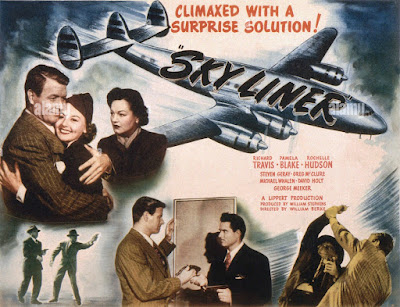Sky Liner is a sixty-one-minute espionage film that takes its time getting airborne. As a double-billed, lower bunk bed offering, it lacks all the excitement expected in a crime film. Had it been released today, it would have gone directly to subscription streaming. It is Cold War mania as a handsome FBI agent gets caught up tracking down pesky Communists on a westbound flight. The storyline is a bit hard to follow with an opening set-up leaving the viewer wanting explanations, mostly about who signed off on the haphazard music score. Lippert Pictures produced a boring, yet fast-paced film. Quite a feat. On a positive note, the second half of this film is more interesting. Perhaps the only recognizable actor in this “air-noir” is Richard Travis, yet he is mostly known for one film, the 1942 comedy, The Man Who Came to Dinner. His laid-back, slightly naive supporting role worked well for him there. For this film, the FBI agent is laid back from the opening nearly to the halfway point before establishing his identity. The movie starts to gel with his involvement, yet he is unable to ignite a single spark plug.
A sharp-shadowed silhouette with a revolver in hand enters the office of an American State Department official. A bit of visual trickery as viewers expect a gunshot to ring out. But the attacker simply uses a well-placed butt of his gun to the skull, resulting in manslaughter. Assuming the identity of the late official, he boards the plane with Rochelle Hudson, secretary to the official. Unfortunately, it will not be necessary for the imposter to fasten his seat belt before landing. Travis, with the help of a stewardess, Pamela Blake, set a trap for the murderer on board and intercept Hudson before she defects to the Soviet Union. When confronted, the traitor reveals information helpful to the moviegoers.
Travis quickly wraps up the plot essentials with Blake in case there are still those puzzled before leaving the theater. What is truly puzzling is why two elderly ladies—in early twentieth-century apparel—close out the film amusingly. It is totally without precedent and not as useful as Sid Melton's obligatory appearances could be in Lippert's films. Caught up in their own fantasy, they watch with hearts aflutter as Travis and Blake kiss before entering the terminal. The duo decides then and there to apply for an exciting position as stewardesses.
Note: There are many low-budget films where airliner continuity is of no concern to the director. Obtaining stock footage could be expensive or difficult to come by. The worst examples have a plane taking off as one type and then "transforming" in flight into a different type or airline. The triple-tailed TWA Lockheed Constellation in this film remains intact throughout, even if subtle markings do not. No doubt, the aerial footage may have come from TWA or Lockheed for promotional purposes. Perhaps a case in point, that final landing in the film—at the recently named Los Angeles International Airport—is just opposite the Lockheed factory.


No comments:
Post a Comment